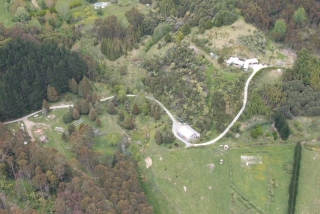At the end of World War II, John Hoyle Furniss (John Furniss’ grandfather and after whom he was named) moved from the damp misty peat lands of Rotowaro near Huntly to Ahuroa near Warkworth. He sold his dairy farm to the Government, who subdivided it into rehabilitation farms for soldiers returning from war. What he bought in Ahuroa was a partially logged crown logging lease. The neighbor, who had the lease prior, had a team of 6 bullocks and a couple of crosscut saws and he, his sons and grandsons had a timber jack each made by Prices Engineering in Thames.
John Hoyle Furniss, being of some means and a progressive farmer and land developer, ordered a new d4d=7u and a twin cylinder IEL chainsaw and plants for his new farm. He also cunningly called his son, (also a John Furniss) and his son in law Warren Martin, back from their respective flying roles in the RAF and the RNZAF. They named the place “Woodlands”, and employed bush men to help them log, road and fence the property. Kanuka was cut to fill orders for the Auckland Hospital boilers and other species were sold to local mills including Kauri. Less commercially valuable logs like Rata, Kaihikatea, Rewarewa and Libocedar were also sawn for farm timber and used to build the woolshed, houses and stockyards.
An early influence on John Hoyle Furniss was Tudor Collins, who spent time in his youth working with Kauri in the North and later documented this with his photography (among his many talents). He prevailed on John to save a significant large diameter short boled Kauri tree on the property. John agreed to save it so all the bush residue was pushed back several chains from the tree and then burnt. The burn was a good and hot one, but unfortunately created its own tornado and many burning branches were drawn up high into the sky, only to rain down flaming into the gum deposits in the head and forks of the big Kauri tree. All they could do was look on in horror as the big tree burned.
Following this unfortunate accident, the tree was subsequently felled and loaded on to a new truck (the tree was 17500 super feet or about 42 cubic metres) and bent the truck. As it was delivered to the mill, the mill then promptly declared bankruptcy.
Another influence was Neil Barr who lived just down the road. He convinced John Furniss and son, to plant the rough gullies on the property (these being the reason the bullocky had left such a large area unworked) with some tree species he thought showed promise, being Eucalyptus Saligna and Botryoides. There were many planted in the local area due to his influence.
Many years later, the current John Furniss of Ahuroa, bought a piece of the farm from the estate and shortly after attended his first farm forestry field day. Having a similar inclination, he has continued the planting legacy and planted quite a few trees himself, such as Radiatas, Blackwoods and more Eucalypts, particularly the Pilualris (also at Neil’s suggestion) and Microcorys species, largely based on the timber characteristics. Of all the different tree species planted at Woodlands, the Eucalypts seem to be the most bullet proof and have the nicest form.
John then bought a Peterson 10inch portable mill and much learning took place. The floor of Johns new house is Saligna as is some of the wall framing. He is now making household joinery (windows and doors) using both Saligna and Botryoides among other woods. He now also has a hydraulically optioned Wood-Mizer bandsaw which makes it much easier to quartersaw and resaw. Both saws are portable and allow him to be more mobile to meet the demands of his customers.










